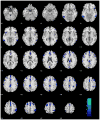Changes in cerebral morphometry and amplitude of low-frequency fluctuations of BOLD signals during healthy aging: correlation with inhibitory control
- PMID: 23553547
- PMCID: PMC3760988
- DOI: 10.1007/s00429-013-0548-0
Changes in cerebral morphometry and amplitude of low-frequency fluctuations of BOLD signals during healthy aging: correlation with inhibitory control
Abstract
Aging is known to be associated with changes in cerebral morphometry and in regional activations during resting or cognitive challenges. Here, we investigated the effects of age on cerebral gray matter (GM) volumes and fractional amplitude of low-frequency fluctuation (fALFF) of blood oxygenation level-dependent signals in 111 healthy adults, 18-72 years of age. GM volumes were computed using voxel-based morphometry as implemented in Statistical Parametric Mapping, and fALFF maps were computed for task-residuals as described in Zhang and Li (Neuroimage 49:1911-1918, 2010) for individual participants. Across participants, a simple regression against age was performed for GM volumes and fALFF, respectively, with quantity of recent alcohol use as a covariate. At cluster level p < 0.05, corrected for family-wise error of multiple comparisons, GM volumes declined with age in prefrontal/frontal regions, bilateral insula, and left inferior parietal lobule (IPL), suggesting structural vulnerability of these areas to aging. FALFF was negatively correlated with age in the supplementary motor area (SMA), pre-SMA, anterior cingulate cortex, bilateral dorsal lateral prefrontal cortex (DLPFC), right IPL, and posterior cingulate cortex, indicating that spontaneous neural activities in these areas during cognitive performance decrease with age. Notably, these age-related changes overlapped in the prefrontal/frontal regions including the pre-SMA, SMA, and DLPFC. Furthermore, GM volumes and fALFF of the pre-SMA/SMA were negatively correlated with the stop signal reaction time, in accord with our earlier work. Together, these results describe anatomical and functional changes in prefrontal/frontal regions and how these changes are associated with declining inhibitory control during aging.
Figures




References
Publication types
MeSH terms
Grants and funding
LinkOut - more resources
Full Text Sources
Other Literature Sources

